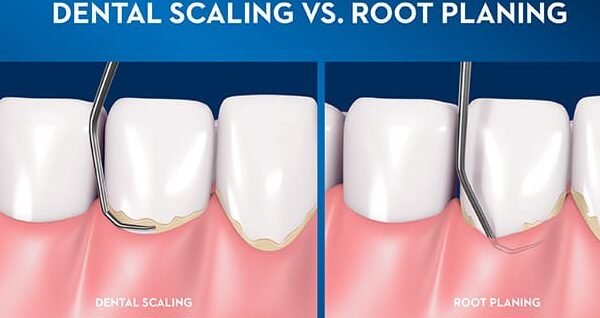Table of Contents
Understanding Scaling and Root Planing: An Overview
Scaling and root planing is a common dental procedure aimed at treating gum disease. It is a non-surgical method designed to remove plaque, tartar, and bacterial toxins from the surfaces of your teeth and roots. This deep cleaning process allows your gums to heal and prevents further damage to the supporting structures of your teeth.
During scaling, your dentist or dental hygienist will use specialized instruments to gently remove the buildup of plaque and tartar from the areas above and below your gumline. This includes not only the visible tooth surfaces but also the roots of your teeth. Root planing, on the other hand, involves smoothing out rough areas on the roots to prevent bacteria from reattaching and causing more damage.
The overall goal of scaling and root planing is to reduce the inflammation in your gums, tighten loose teeth, and prevent tooth loss. By removing the harmful bacteria and promoting a clean oral environment, this procedure helps restore and maintain the health of your teeth and gums. It is an essential step in preventing and managing gum disease, ensuring a healthy and beautiful smile for years to come.

The Purpose and Benefits of Scaling and Root Planing
Scaling and root planing, also known as deep cleaning, is a non-surgical procedure used to treat gum disease and prevent further oral health complications. The purpose of scaling and root planing is twofold: to remove plaque and tartar buildup below the gumline and to smooth the surfaces of the tooth roots, eliminating bacterial toxins and promoting the healing of gum tissue.
By removing plaque and tartar buildup, scaling and root planing helps to eliminate harmful bacteria that can lead to gum disease. The procedure also helps to reduce the depth of periodontal pockets, the spaces between the gums and teeth where bacteria accumulate. This reduction in pocket depth allows the gums to reattach to the teeth, preventing further bacterial growth and reducing the risk of tooth loss.
In addition to treating gum disease, scaling and root planing offers several benefits. One of the key benefits is the prevention of further oral health issues. By removing plaque and tartar buildup, the procedure reduces the risk of tooth decay, gum infections, and tooth loss. Scaling and root planing also helps to improve the appearance of the teeth and gums by reducing inflammation and promoting healthy gum tissue. Overall, this procedure plays a crucial role in maintaining optimal oral health and preventing the progression of gum disease.
| Purpose of Scaling and Root Planing | Benefits of Scaling and Root Planing |
|---|---|
| Remove plaque and tartar buildup from tooth surfaces | Reduces inflammation and risk of gum disease |
| Smooths tooth roots to prevent bacterial adhesion | Halts progression of periodontal disease |
| Promotes gum tissue healing and attachment | Prevents tooth loss and preserves oral health |
| Controls bacterial infection in periodontal pockets | Improves overall oral hygiene and freshens breath |
| Facilitates maintenance of healthy gums and teeth | Enhances long-term dental health and wellness |
Determining the Need for Scaling and Root Planing
Determining the Need for Scaling and Root Planing
During a routine dental examination, your dentist may recommend scaling and root planing as a treatment option. But how do they determine if you need this procedure? The decision is based on a comprehensive evaluation of your oral health.
First, your dentist will examine your teeth and gums, checking for signs of gum disease such as redness, swelling, or bleeding. They will also measure the depth of your gum pockets using a periodontal probe. In healthy gums, the pocket depth is typically less than 3 millimeters. However, pockets deeper than this indicate the presence of gum disease.
X-rays may also be taken to evaluate the bone level surrounding the teeth. This helps your dentist assess the extent of bone loss and determine the severity of gum disease. Additionally, they may consider your medical history, lifestyle habits, and other risk factors that contribute to periodontal health.
By thoroughly evaluating the condition of your gums, your dentist can determine the need for scaling and root planing. It is important to address gum disease promptly to prevent further damage and maintain optimal oral health. In the next section, we will delve into the procedure itself and provide a step-by-step explanation.
The Procedure: Step-by-Step Explanation
Scaling and root planing is a common dental procedure that is typically performed by a dental hygienist or periodontist. It is a thorough cleaning of the teeth and gums aimed at removing plaque, tartar, and bacteria from below the gumline. The procedure is an important part of treating gum disease and preventing its progression.
The first step in scaling and root planing is numbing the gum tissue with a local anesthesia to ensure that the patient remains comfortable throughout the procedure. Once the area is numb, the dental professional will use specialized tools to carefully remove the plaque and tartar from the tooth surfaces and below the gumline. This process, known as scaling, helps to remove the source of the bacteria and prevent further damage to the gums. After scaling, the dental professional will then smooth out the rough surfaces of the tooth roots, a process called root planing. This smoothing helps the gums reattach to the teeth and promotes healing. The procedure is usually done in multiple visits, with each visit focusing on a specific section of the mouth to ensure thorough cleaning.

Preparing for Scaling and Root Planing: What to Expect
Preparing for scaling and root planing can help ensure a smooth and successful experience. Before the procedure, your dentist will provide detailed instructions on what you should expect and how to best prepare. It is important to follow these guidelines to maximize the benefits of the treatment and minimize any potential discomfort.
One of the key aspects of preparation is maintaining good oral hygiene leading up to the procedure. This includes regular brushing and flossing to remove plaque and tartar buildup. Your dentist may also recommend using an antimicrobial mouthwash to further reduce bacteria in the mouth. Additionally, it is important to disclose any medications or health conditions to your dentist, as this information can impact the procedure and the use of local anesthesia. By following these guidelines, you can ensure that your mouth is in the best possible condition for scaling and root planing, leading to optimal results and improved oral health.
The Role of Local Anesthesia in Scaling and Root Planing
Local anesthesia plays a crucial role in ensuring a comfortable and pain-free experience during scaling and root planing procedures. Scaling and root planing involves the deep cleaning of the teeth and gums, which can be quite sensitive and potentially painful without the numbing effect of anesthesia.
The use of local anesthesia helps to alleviate any discomfort or pain that may arise during the procedure. By blocking the pain signals from reaching the nerves in the mouth, patients can undergo scaling and root planing with minimal discomfort. The anesthesia is administered by a skilled dental professional, typically through a local injection around the treatment area.
Local anesthesia not only provides pain relief during the procedure but also allows the dentist or hygienist to perform a more thorough cleaning. Without the discomfort caused by sensitive teeth and gums, they can focus on removing plaque, tartar, and bacteria from deep pockets and exposed roots. This helps to prevent further progression of gum disease and promotes better gum health.
Overall, the role of local anesthesia in scaling and root planing is essential for ensuring patient comfort and allowing for effective treatment. By numbing the treatment area, it enables dental professionals to deliver a comprehensive and thorough cleaning, leading to improved oral health outcomes.

Managing Discomfort During and After the Procedure
Managing discomfort during and after scaling and root planing is an important aspect of the procedure. While the treatment itself is designed to improve oral health and alleviate gum disease symptoms, it can cause temporary discomfort and sensitivity. However, there are several strategies that can help patients manage this discomfort and ensure a smoother recovery process.
First, it’s essential to follow the post-treatment instructions provided by your dentist. These instructions may include recommendations such as avoiding hard, crunchy foods, using a soft-bristled toothbrush, and practicing gentle oral hygiene. Additionally, over-the-counter pain relievers, such as ibuprofen, can help manage any discomfort or swelling. Applying a cold pack to the outside of the mouth for short periods can also provide relief. However, it’s important to consult with your dentist before taking any medication or using cold packs to ensure it is within the recommended guidelines for your specific case. By following these guidelines and staying in communication with your dentist, discomfort can be minimized during the recovery process.
Potential Risks and Complications of Scaling and Root Planing
Scaling and root planing is a common periodontal procedure that effectively removes plaque, tartar, and bacteria from below the gumline. While the procedure is generally safe and well-tolerated by patients, it is important to be aware of the potential risks and complications that may arise. It is worth noting, however, that these risks are rare and can be minimized with proper preoperative planning and postoperative care.
One potential risk of scaling and root planing is tooth sensitivity. This sensitivity may occur temporarily after the procedure, particularly if the roots of the teeth are exposed during the process. Fortunately, this sensitivity typically subsides within a few days or weeks as the gums heal and reattach to the teeth. In some cases, using desensitizing toothpaste or gels can help alleviate discomfort.
Another potential complication, although uncommon, is infection. Scaling and root planing involves deep cleaning of the gums and tooth roots, which can create an avenue for bacteria to enter the bloodstream. In patients with compromised immune systems or certain underlying medical conditions, such as heart disease or diabetes, there might be a slightly increased risk of infection. However, proper sterilization techniques and post-operative antibiotics, when warranted, can significantly reduce this risk. It is crucial for dentists to assess each patient’s medical history and overall health status before proceeding with the procedure.
While these potential risks and complications exist, the benefits of scaling and root planing often outweigh them. It is important to consult with a qualified dental professional who can provide a comprehensive evaluation and personalized treatment plan. By discussing any concerns or existing health issues, patients can ensure a safe and successful scaling and root planing experience.
Post-Treatment Care: Tips for Optimal Healing
A smooth and successful recovery is crucial after undergoing scaling and root planing. Following proper post-treatment care tips can significantly aid in optimal healing and ensure long-lasting results. While the procedure helps combat gum disease and restore oral health, individuals must be proactive in their aftercare to minimize discomfort and promote healing.
One essential tip for post-treatment care is to gently brush and floss your teeth. However, it is crucial to avoid the treated areas for a few days to allow the gums to heal properly. Using a soft-bristle toothbrush and a gentle, circular motion can help maintain oral hygiene without causing irritation. Additionally, rinsing your mouth with solution or warm saltwater can assist in reducing swelling and promoting healing. These simple yet effective habits can aid in optimal recovery after scaling and root planing, ensuring that the treated areas heal well and prevent further complications.
Monitoring and Maintenance: Follow-up Appointments
Follow-up appointments are a crucial part of maintaining oral health after scaling and root planing. These appointments are typically scheduled a few weeks after the procedure to assess the progress and provide necessary care. During these appointments, your dentist or periodontist will evaluate the healing process, check for any signs of infection or complications, and ensure that your gums are getting healthier.
Regular follow-up appointments are essential to monitor the long-term effects of scaling and root planing. Through these appointments, your dentist can assess the success of the treatment, making necessary adjustments if needed. They may also take additional measurements to evaluate the progress of your oral health and stability of the treated areas. Your dentist will provide guidance on maintaining proper oral hygiene, discuss any concerns you might have, and recommend any further steps to improve your oral health. These follow-up appointments play a vital role in ensuring optimal healing and long-lasting results.
Long-Term Effects of Scaling and Root Planing
Long-Term Effects of Scaling and Root Planing
Maintaining good oral health is crucial for overall well-being. When it comes to treating gum disease, scaling and root planing is a highly effective procedure that not only tackles the symptoms but also provides long-term benefits. One of the key long-term effects of scaling and root planing is the prevention of further progression of gum disease. By removing plaque, tartar, and bacteria from below the gum line, this procedure helps to halt the advancement of gum disease, preventing the destruction of gum tissue and underlying bone.
In addition to its preventive role, scaling and root planing also promotes gum tissue healing and reattachment. The thorough cleaning of the root surfaces encourages new, healthy gum tissue to grow and reattach to the tooth, forming a strong and stable connection. This helps to minimize pocket formation and reduces the likelihood of bacteria accumulating in these pockets, leading to recurrent gum infections. By addressing the underlying cause of gum disease and promoting tissue healing, scaling and root planing sets the stage for long-term oral health and enables patients to maintain healthier gums and teeth for years to come.
Improving Oral Hygiene Habits for Lasting Results
Improving oral hygiene habits is crucial for maintaining long-lasting results after scaling and root planing. While the procedure effectively removes plaque and tartar buildup, it is essential to implement daily oral care practices to prevent further gum disease and promote optimal healing.
First and foremost, proper brushing techniques are key to maintaining oral health. Using a soft-bristle toothbrush and fluoride toothpaste, gently brush your teeth at least twice a day for two minutes each time. Be sure to clean all surfaces of your teeth, including the front, back, and chewing surfaces.
In addition to brushing, flossing plays a vital role in removing plaque and bacteria from between your teeth and along the gumline. It is recommended to floss at least once a day, using a gentle back-and-forth motion and taking care not to snap the floss against your gums.
Furthermore, regularly using an antimicrobial mouthwash can help kill bacteria and freshen your breath. Look for mouthwashes that contain ingredients such as chlorhexidine or cetylpyridinium chloride, which have been proven effective in reducing plaque and gingivitis.
Lastly, scheduling regular dental check-ups and cleanings every six months is crucial for maintaining oral health. Your dentist can monitor your progress, identify any potential issues, and provide professional cleanings to remove any remaining plaque or tartar.
By diligently following these oral hygiene practices, you can enhance the longevity of the results achieved through scaling and root planing and promote a healthy smile.
The Connection Between Scaling and Root Planing and Gum Disease
Gum disease, also known as periodontal disease, is a concerning oral health condition that affects millions of people worldwide. It is characterized by inflammation, infection, and damage to the gums and supporting structures of the teeth. If left untreated, gum disease can lead to tooth loss and other serious complications.
Scaling and root planing is a crucial treatment in the battle against gum disease. It is a deep cleaning procedure that aims to remove plaque, tartar, and bacteria from the surfaces of the teeth and the roots below the gumline. By eliminating these harmful substances, scaling and root planing helps to reduce inflammation, promote gum healing, and prevent further progression of gum disease. This treatment is often recommended for patients with gum disease, as it targets the underlying cause of the condition and provides a solid foundation for oral health restoration.
| Scaling and Root Planing | Gum Disease |
|---|---|
| Procedure to remove plaque and tartar buildup from tooth surfaces and root surfaces | Chronic inflammatory condition affecting the gums |
| Helps to eliminate bacteria and toxins causing gum inflammation | Caused by bacteria in plaque irritating the gums |
| Prevents progression of gingivitis to more severe periodontal disease | Can lead to gum recession, tooth loss, and systemic health issues if left untreated |
| Often recommended for patients with periodontal pockets or signs of gum disease | Symptoms include swollen, red, or bleeding gums |
| Aims to promote healing of gum tissue and reduce pocket depths | Treatment involves regular dental cleanings, good oral hygiene, and possibly antibiotics |
Scaling and Root Planing vs. Other Periodontal Treatments
Scaling and root planing is a commonly used treatment for periodontal disease, but it is important to understand how it compares to other periodontal treatments. One notable difference is that scaling and root planing is a non-surgical procedure, whereas other treatments such as periodontal surgery may require incisions and sutures. This makes scaling and root planing a less invasive option for patients who prefer a more conservative approach to their periodontal care.
Another difference lies in the target areas of treatment. Scaling and root planing specifically focuses on removing plaque and tartar buildup from the root surfaces of the teeth and smoothing out the root surfaces to promote healing and reattachment of the gum tissue. Other periodontal treatments, on the other hand, may involve more complex procedures such as bone grafting, gum grafting, or placement of dental implants.
It is important to note that the effectiveness of each treatment may vary depending on the severity of the periodontal disease and the individual patient’s response to treatment. Therefore, it is crucial to consult with a dental professional who can assess your specific needs and determine the most appropriate treatment plan for you.
Success Stories: Patient Experiences with Scaling and Root Planing
Scaling and root planing is a common treatment for individuals with gum disease. Many patients have had positive experiences with this procedure and have seen significant improvements in their oral health. One patient, John, had been struggling with gum disease for years and was experiencing symptoms such as bleeding gums and bad breath. After undergoing scaling and root planing, John noticed a remarkable change in his condition. He reported that his gums became healthier, the bleeding reduced, and his breath significantly improved. John mentioned that the procedure was comfortable and that the dentist provided thorough explanations throughout the process, which helped ease his anxiety.
Another success story comes from Sarah, who had neglected her oral hygiene for some time, leading to gum disease. Sarah was scared about the prospect of scaling and root planing but was relieved to find out that the procedure was not as daunting as she imagined. She shared that her dentist was gentle and understanding, which made her feel more at ease. After the treatment, Sarah saw a remarkable improvement in the appearance of her gums and experienced a decrease in gum sensitivity. She now maintains regular oral hygiene habits and visits her dentist for regular check-ups to prevent any future issues.
These success stories highlight the positive outcomes that patients can achieve through scaling and root planing. While experiences may vary, it is crucial to consult with a dental professional to determine the most suitable treatment options for individual oral health needs.
How long does the scaling and root planing procedure typically take?
The duration of the scaling and root planing procedure depends on the extent of the treatment needed. It can take anywhere from one to four appointments to complete.
Will scaling and root planing completely cure my gum disease?
Scaling and root planing is a crucial step in treating gum disease, but it may not completely cure it. Regular follow-up appointments and maintaining good oral hygiene habits are important for long-term management of gum disease.
Is scaling and root planing a painful procedure?
Local anesthesia is used during scaling and root planing to minimize discomfort. While some patients may experience mild discomfort during and after the procedure, it is generally well-tolerated.
How soon can I resume my normal oral hygiene routine after scaling and root planing?
It is important to wait until any soreness or tenderness subsides before resuming your regular oral hygiene routine. Your dentist or dental hygienist will provide specific instructions on when to start brushing and flossing again.
Can scaling and root planing cause tooth sensitivity?
It is possible to experience temporary tooth sensitivity after scaling and root planing. This sensitivity usually subsides within a few days or weeks. Using desensitizing toothpaste may help alleviate any discomfort.
Are there any long-term effects of scaling and root planing?
Scaling and root planing can lead to long-term benefits such as improved gum health, reduced pocket depths, and prevention of further progression of gum disease. However, regular follow-up appointments and diligent oral hygiene are necessary to maintain these results.
How often do I need to schedule follow-up appointments after scaling and root planing?
The frequency of follow-up appointments will depend on the severity of your gum disease and your dentist’s recommendation. Typically, follow-up appointments are scheduled every three to six months to monitor your oral health.
Can scaling and root planing be performed on all patients with gum disease?
Scaling and root planing is a common treatment for gum disease, but it may not be suitable for all patients. Your dentist will evaluate your oral health and determine if you are a candidate for this procedure or if alternative treatments are necessary.
Can scaling and root planing prevent tooth loss?
Scaling and root planing can help prevent tooth loss by addressing the underlying gum disease that can lead to tooth loss. However, the success of the treatment also depends on maintaining good oral hygiene and attending regular dental check-ups.
How soon can I see improvements in my gum health after scaling and root planing?
Improvements in gum health can vary from patient to patient. In general, you may start noticing improvements such as reduced gum inflammation and bleeding within a few weeks of the procedure. It is important to continue with proper oral hygiene habits for optimal results.




